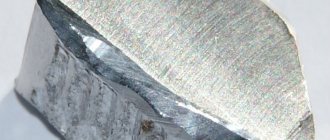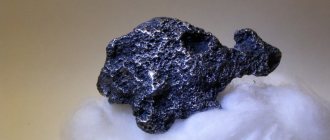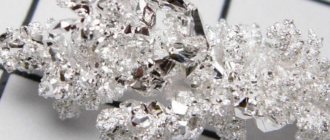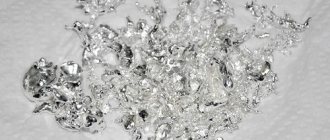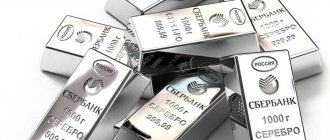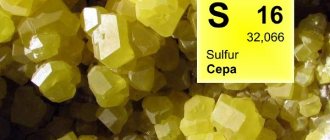Today, aluminum is one of the most popular metals, which is used both in many industries and in the everyday life of every person. It is surprising that this metal, which was considered more expensive than gold just a century and a half ago, has taken a strong position in the market and continues to be in great demand.
Differences in saturation
Aluminum ore is a rock from which metal is extracted. Aluminum does not exist in its pure form in nature; it is a chemical element that can be found in many compounds, but of varying saturation. Due to the greatest profitability, aluminum is currently mined from bauxite, alunite and nepheline.
Bauxite contains the highest concentration of aluminum oxide (50% or more). They are the main source of alumina, that is, the main raw material from which aluminum is produced.
In second place in terms of aluminum concentration in the composition are alunites, which contain up to 40% alumina.
Nephelines settled in the third position. They are an alkaline formation that contains up to 25% alumina.
All other compounds contain alumina in lower concentrations and are unprofitable in the aluminum mining process.
STRUCTURE
Cubic face-centered structure. 4 orange atoms
The crystal lattice of aluminum is a face-centered cube, which is stable at temperatures from 4°K to the melting point. There are no allotropic transformations in aluminum, i.e. its structure is permanent. The unit cell consists of four atoms with a size of 4.049596×10-10 m; at 25 °C, the atomic diameter (the shortest distance between atoms in the lattice) is 2.86 × 10-10 m, and the atomic volume is 9.999 × 10-6 m3/g-atom. Impurities in aluminum have little effect on the lattice parameter. Aluminum has great chemical activity; the energy of formation of its compounds with oxygen, sulfur and carbon is very high. In the voltage series, it is among the most electronegative elements, and its normal electrode potential is -1.67 V. Under normal conditions, interacting with atmospheric oxygen, aluminum is covered with a thin (2-10-5 cm) but durable film of aluminum oxide A1203, which protects against further oxidation, which determines its high corrosion resistance. However, if Hg, Na, Mg, Ca, Si, Cu and some other elements are present in aluminum or the environment, the strength of the oxide film and its protective properties are sharply reduced.
Properties of aluminum ore
Aluminum was highly valued by our ancestors, who discovered this metal almost two centuries ago, and remains relevant to this day. Below are the main properties of aluminum, thanks to which this metal is especially valuable:
- belongs to the group of light metals;
- huge deposits - aluminum ranks third after oxygen and silicon in terms of distribution on Earth;
- high degree of ductility - the metal is easy to machine, cast, polish, etc.;
- has a high degree of heat and energy conductivity;
- high reflectivity - up to 90%;
- corrosion resistance;
- nice shiny appearance.
Technology for developing aluminum deposits
The most important role in the production of aluminum is played by bauxite, which contains the highest concentration of alumina. Bauxite itself is a complex rock, and its extraction is based on several main methods:
- open - considered the main and most popular method, which is used if the aluminum ore lies shallow (most often it is bauxite);
- underground (otherwise known as mine) method. This method of extracting aluminum ore is similar in principle to the extraction of coal in mines (hence the name).
When choosing a method for processing an aluminum ore deposit, factors such as the type of deposit, as well as the geological conditions of its occurrence (for example, horizontal or inclined) are taken into account.
The process of cutting away layers of aluminum-bearing rocks also depends largely on their type and structure. Below are the two most common methods:
- Cutting using a milling method, when surface miners come to the rescue. Thanks to these machines (which also differ in their properties depending on the model), a layer is cut, the thickness of which can reach 600 mm. Aluminum rocks are processed in this way gradually. After removing each layer, so-called “shelves” are formed.
- An alternative to the milling of aluminum ore, especially loose ore, is the operation of quarry excavators. This method is used if it is necessary to immediately load ore onto dump trucks for further transportation.
Aluminum ore mining methods
It is impossible to extract aluminum directly from ore; it oxidizes too quickly. For this reason, the valuable metal is obtained in several stages:
- Extraction of alumina (aluminum oxide) from aluminum ores with subsequent transportation using dump trucks to processing plants.
- Producing aluminum from alumina is the most difficult and time-consuming part of the process:
- minerals are crushed using crushing machines;
- then sintered in ovens;
- subsequently, leaching occurs with the help of strong alkalis - the period of raw material processing. It is worth noting that alumina can be extracted using various methods: acidic, electrolytic and alkaline. The most popular method is the alkaline method, it was used back in the 18th century;
- decomposition, i.e. a process in which the resulting aluminate pulp enters the separation, where the liquid component is evaporated;
- refining of aluminum, otherwise - purification from excess alkalis;
- calcination in ovens is the final stage.
As a result of complex operations, dry alumina is obtained. Pure aluminum is obtained from this raw material using hydrolysis treatment.
In order to obtain 1 ton of pure aluminum, it is necessary to extract 2 tons of alumina. This amount of alumina will be contained in approximately 4–4.5 tons of bauxite. The number of alunites or nephelites should, accordingly, be even greater. It is easy to conclude that the extraction and production of aluminum is a complex, energy-intensive and costly process.
Production of aluminum by electrolysis
Electrolytic reduction of aluminum oxide dissolved in a cryolite-based melt is carried out at 950-970 °C in an electrolyzer. The electrolyzer consists of a bath lined with carbon blocks, to the bottom of which electric current is supplied. The liquid aluminum released on the hearth, which serves as the cathode, is heavier than the molten salt of the electrolyte, therefore it is collected on a coal base, from where it is periodically pumped out (Figure 4). Carbon anodes are immersed in the electrolyte on top, which burn in an atmosphere of oxygen released from aluminum oxide, releasing carbon monoxide (CO) or carbon dioxide (CO2). In practice, two types of anodes are used:
- self-burning Zederberg anodes, consisting of briquettes, the so-called “bread” of Zederberg mass (low-ash coal with 25 - 35% coal tar pitch), stuffed into an aluminum shell; under the influence of high temperature the anode mass is burned (sintered);
- baked, or "continuous", anodes made from large carbon blocks (e.g. 1900 × 600 × 500 mm weighing about 1.1 t).
Figure 4 – Electrolyzer diagram
The current strength in the electrolysers is 150,000 A. They are connected to the network sequentially, i.e., a system (series) is obtained - a long row of electrolysers.
The operating voltage on the bath, 4–5 V, is significantly higher than the voltage at which aluminum oxide decomposes, since voltage losses in various parts of the system are inevitable during operation. The balance of raw materials and energy when producing 1 ton of aluminum is presented in Figure 5.
Figure 5 – Balance of raw materials and energy when producing 1 ton of aluminum
In the reaction vessel, aluminum oxide is converted first to aluminum chloride. Then, in a tightly insulated bath, electrolysis of AlCl3 dissolved in the molten salts KCl and NaCl occurs. The chlorine released during this process is sucked off and supplied for recycling; aluminum is deposited on the cathode.
The advantages of this method over the existing electrolysis of liquid cryolite-alumina melt (Al2O3, Na3AlF6 dissolved in cryolite) are: saving up to 30% of energy; the possibility of using aluminum oxide, which is not suitable for traditional electrolysis (for example, Al2O3 with a high silicon content); replacing expensive cryolite with cheaper salts; disappearance of the danger of fluoride release [7].
Applications of Aluminum Ore
It is difficult to imagine the modern world without aluminum. The range of its applications is very wide, and sometimes we do not imagine how important this metal is in our lives.
Aluminum is widely used in mechanical and automotive industry, aviation, construction, glass industry, as well as in the production of electrical equipment and other small consumer goods (for example, foil).
A particularly interesting fact is that aluminum is also present in our lives as a food additive under the code E173. This additive is approved as a food coloring in a number of countries, including Russia. This dye is most often used in the confectionery industry due to the fact that it gives products a beautiful silvery tint. However, it is not a safe supplement and doctors strongly recommend consuming it in very moderation and with caution.
Aluminum ore has a rich composition, and in addition to aluminum, other chemical elements are extracted from it. These are mainly non-ferrous metals, which are later used to improve the quality of steel, as well as titanium, vanadium, chromium, etc.
The recovered alumina is also useful in the iron and steel industry, where it is used as fluxes.
When the ore extracted from bauxite is smelted in electric furnaces, another material called electrocorundum is produced. It is especially valuable due to its hardness (second only to diamond) and is in demand as an abrasive.
During the aluminum production process, waste is also generated, which is called red mud. They contain the element scandium, which is especially in demand in many sectors of both heavy (automotive, rocket production) and light (production of electric drives, sports equipment) industries.
Industry enterprises
It is quite difficult to indicate which city is the center of the aluminum industry. This is due to the fact that in all regions where the industry is developed, there are many settlements with corresponding factories, combines and other enterprises.
Large factories
The most significant enterprises of the aluminum industry are located in the Siberian Federal District. They are located in large and small cities of various regions of Russia.
Main factories in the industry:
- NAZ. The Novokuznetsk enterprise is located in the Kemerovo region. It began its work back in 1943, when it was exclusively engaged in the production of military equipment for aviation. The main activities of the plant are the production of aluminum alloys and primary aluminum. The production capacity of NAZ is 215 thousand tons per year.
- IAZ. The aluminum plant in the city of Shelekhov (Irkutsk region) offers customers a wide range of products. It includes wire rod, aluminum alloys, strips and primary aluminum. The company has been operating since 1962. Nowadays, it employs 2.4 thousand people and produces up to 400 thousand tons of aluminum products per year. The main consumers are construction companies and aviation industry enterprises.
- SAZ. The Sayanogorsk aluminum smelter is based in the Republic of Khakassia. It was built relatively recently (1985), therefore it is the main testing site for RUSAL's developments. The company produces primary aluminum and various alloys in the form of ingots or pigs. The plant's production capacity is 542 thousand tons of metal per year.
- KAZ. This aluminum plant in Krasnoyarsk is one of the largest in Russia. It annually produces about 1 million tons of products, which include not only primary aluminum and alloys, but also high-purity metal. The latter is no longer produced at any plant in Russia or the countries of the former USSR. KAZ employs 4.2 thousand people. However, regular expansion of production constantly requires additional human resources.
- BAZ. The Bratsk Aluminum Plant began operations in 1966. Nowadays, it is the largest enterprise in the industry not only in Russia, but also in the world. The plant annually produces more than 1 million tons of primary aluminum and its alloys, which is also the best figure on the planet. At BAZ, equipment is constantly being improved and productivity is increasing. In addition, plant managers pay great attention to the implementation of various environmental programs.
